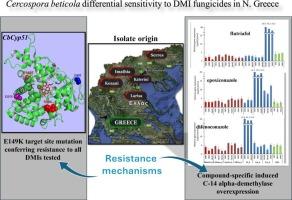一种新的靶位位点修饰和C-14 α -去甲基化酶过表达介导了甜菜Cercospora beticola对DMI杀菌剂的差异敏感性
IF 4
1区 农林科学
Q2 BIOCHEMISTRY & MOLECULAR BIOLOGY
引用次数: 0
摘要
对从希腊北部采集的300株斑点孢菌的敏感性评估显示,38%的人群对去甲基化酶抑制剂(DMIs)中至少一种高度耐药,包括异丙唑、环环唑和氟triafol。对氟triafol、epoxiconazole和difenoconazole最耐药菌株的耐药因子分别大于50、100和100。抗dmi菌株在菌丝生长、产孢和致病性方面存在适应性损失,这可能是它们在田间出现频率较低的原因。Pearson相关分析显示,三种dmi之间存在正交叉耐药关系,表明在观察到的表型中存在靶基因(CbCyp51)相关的耐药机制。对敏感菌株和抗dmi菌株的CbCyp51基因序列分析显示,只有对三种杀菌剂均耐药的C. beticola菌株中才存在新的突变(E149K)。据作者所知,这是首次报道这种与所有氟triafol、epoxiconazole和difenoconazole杀菌剂高耐药水平相关的靶位点突变。其余dmi耐药表型未发现靶位点突变。在对氟triafol, epoxiconazole和difenoconazole具有特异性抗性的C. beticola分离株中观察到化合物特异性诱导CbCyp51过表达,而没有发现组成性过表达的迹象。总的来说,本研究的结果提供了对田间dmi高抗性发生机制的见解,并为在希腊甜菜田建立有效的防治策略奠定了基础。本文章由计算机程序翻译,如有差异,请以英文原文为准。

Differential sensitivity to DMI fungicides in Cercospora beticola is mediated by a novel target site modification and C-14 alpha-demethylase overexpression
Sensitivity assessment of 300 Cercospora beticola isolates collected from North Greece revealed that 38 % of the population was highly resistant to at least one of the demethylase inhibitors (DMIs) difenoconazole, epoxiconazole and flutriafol. Resistance factors greater than 50, 100 and 100 were calculated for the most resistant C. beticola isolates to flutriafol, epoxiconazole and difenoconazole, respectively. DMI-resistant isolates carried fitness penalties in terms of mycelial growth, sporulation and pathogenicity, probably accounting for their low frequencies in the field. Pearson correlation analysis revealed a positive cross-resistance relationship between all three DMIs tested suggesting the existence of a target-gene (CbCyp51) related resistance mechanism in the observed phenotypes. Sequence analysis of the CbCyp51 gene from sensitive and DMI-resistant isolates revealed a novel mutation (E149K) present only in C. beticola isolates resistant to all three fungicides tested. To the best of the author's knowledge, this is the first report of this target-site mutation associated with high resistance levels to all flutriafol, epoxiconazole and difenoconazole fungicides. No target-site mutations were found in the rest of DMI-resistance phenotypes. A compound-specific induced CbCyp51 overexpression was observed in C. beticola isolates with specific resistance to flutriafol, epoxiconazole, and difenoconazole, while no indication of constitutive overexpression was found. Overall, the results of the present study provide insights on the mechanisms responsible for the occurrence of high DMI-resistance in the field and a basis for establishing effective strategies for the control of C. beticola in sugar beet fields in Greece.
求助全文
通过发布文献求助,成功后即可免费获取论文全文。
去求助
来源期刊
CiteScore
7.00
自引率
8.50%
发文量
238
审稿时长
4.2 months
期刊介绍:
Pesticide Biochemistry and Physiology publishes original scientific articles pertaining to the mode of action of plant protection agents such as insecticides, fungicides, herbicides, and similar compounds, including nonlethal pest control agents, biosynthesis of pheromones, hormones, and plant resistance agents. Manuscripts may include a biochemical, physiological, or molecular study for an understanding of comparative toxicology or selective toxicity of both target and nontarget organisms. Particular interest will be given to studies on the molecular biology of pest control, toxicology, and pesticide resistance.
Research Areas Emphasized Include the Biochemistry and Physiology of:
• Comparative toxicity
• Mode of action
• Pathophysiology
• Plant growth regulators
• Resistance
• Other effects of pesticides on both parasites and hosts.

 求助内容:
求助内容: 应助结果提醒方式:
应助结果提醒方式:


